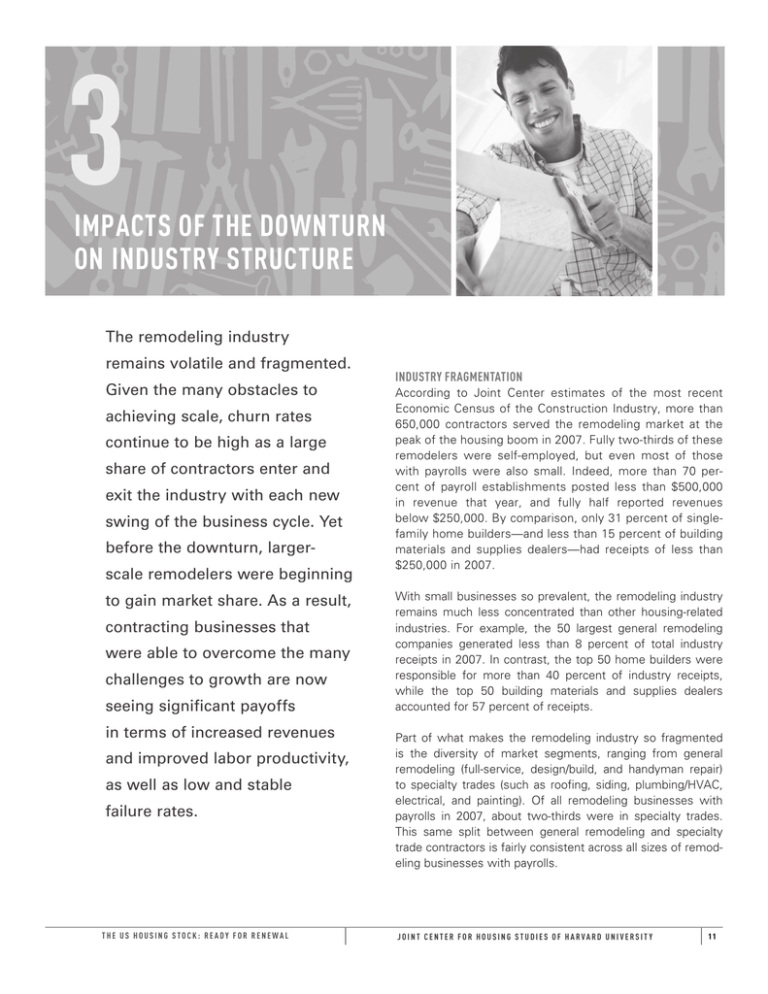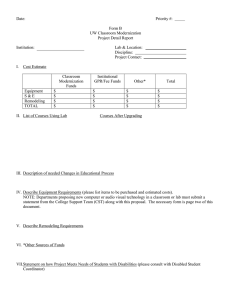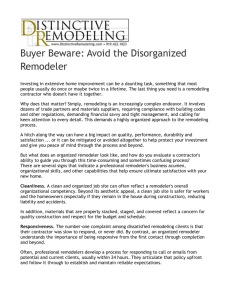3 IMPACTS OF THE DOWNTURN ON INDUSTRY STRUCTURE The remodeling industry
advertisement

3 IMPACTS OF THE DOWNTURN ON INDUSTRY STRUCTURE The remodeling industry remains volatile and fragmented. Given the many obstacles to achieving scale, churn rates continue to be high as a large share of contractors enter and exit the industry with each new swing of the business cycle. Yet before the downturn, largerscale remodelers were beginning to gain market share. As a result, contracting businesses that were able to overcome the many challenges to growth are now seeing significant payoffs in terms of increased revenues and improved labor productivity, as well as low and stable failure rates. THE US HOUSING STOCK: READY FOR RENEWAL INDUSTRY FRAGMENTATION According to Joint Center estimates of the most recent Economic Census of the Construction Industry, more than 650,000 contractors served the remodeling market at the peak of the housing boom in 2007. Fully two-thirds of these remodelers were self-employed, but even most of those with payrolls were also small. Indeed, more than 70 percent of payroll establishments posted less than $500,000 in revenue that year, and fully half reported revenues below $250,000. By comparison, only 31 percent of singlefamily home builders—and less than 15 percent of building materials and supplies dealers—had receipts of less than $250,000 in 2007. With small businesses so prevalent, the remodeling industry remains much less concentrated than other housing-related industries. For example, the 50 largest general remodeling companies generated less than 8 percent of total industry receipts in 2007. In contrast, the top 50 home builders were responsible for more than 40 percent of industry receipts, while the top 50 building materials and supplies dealers accounted for 57 percent of receipts. Part of what makes the remodeling industry so fragmented is the diversity of market segments, ranging from general remodeling (full-service, design/build, and handyman repair) to specialty trades (such as roofing, siding, plumbing/HVAC, electrical, and painting). Of all remodeling businesses with payrolls in 2007, about two-thirds were in specialty trades. This same split between general remodeling and specialty trade contractors is fairly consistent across all sizes of remodeling businesses with payrolls. JOINT CENTER F OR HOUSING STUDIES OF HARVARD UNIVERSIT Y 11 While both home building and remodeling firms are under the same industry umbrella, operations in these two sectors differ widely. In particular, remodelers perform many more smallscale projects than home builders. The types of projects that they undertake are also more diverse, from room additions and exterior replacements to handyman maintenance and repairs. These differences are often great enough to encourage builders and remodelers to specialize on their own core businesses when the economy is booming. But during the recent downturn, remodelers not only had to vie for a shrinking number of projects, they also had to compete against home builders that diversified into remodeling when demand for new homes plummeted. According to member censuses by the National Association of Home Builders (NAHB), the share of single-family home builders that reported residential remodeling as a secondary activity increased steadily from 44 percent in 2008 to 51 percent in 2011. It remains to be seen whether these home building firms continue to pursue remodeling jobs as the construction market recovers. UNDERLYING INDUSTRY CHURN The number of contractors serving the residential remodeling market increased sharply during the housing boom, with the number of payroll businesses up 29 percent from 2001 to 2007 (Figure 11). Industry payroll employment also rose 30 percent over this period. During the housing crash, homeowner improvement spending plunged nearly 25 percent—the largest peak-to-trough drop on record. Even so, the number of general residential remodeling businesses declined by just over 8 percent between 2007 and 2011. Employment at general remodeling firms, however, fell much more sharply and was still down in 2011 by more than 22 percent from the 2006 peak. In fact, at 241,000 employees, employment at general remodeling firms barely exceeded levels posted nearly a decade earlier. The aggregate numbers of remodeling establishments mask the churn in the industry. Regardless of economic conditions, the share of firms that enter and exit the industry is relatively high when compared with either the construction sector as a whole or all US industries. In 2003–04, a boom year for remodeling as well as for the economy, 18 percent of remodeling contractors with payrolls were startups, compared with 14 percent in the construction industry overall and just 10 percent for payroll establishments nationally (Figure 12). By 2009–10, when the economy was still mired in the Great Recession, over 17 percent of residential remodelers had exited the industry, compared with 16 percent of firms in the construction industry and under 10 percent of all US payroll establishments. Regardless of business conditions, though, smaller remodeling companies are much more likely to fail. Remodelers with estimated receipts of less than $250,000 in 2003–04 had a failure rate of about 19 percent that year, and the cyclical downturn knocked out about a quarter of these small firms in 2009–10. In stark contrast, the largest remodeling businesses saw relatively low and stable failure rates over the business cycle (Figure 13). Remodelers with estimated receipts of $1 million or more had an annual failure rate of just 2.7 percent in 2003–04 and sustained this low rate in 2009–10. With the effi- Figure 11 The Numbers of Both Remodeling Businesses and Employees Declined Significantly During the Downturn General Remodeling Establishments (Thousands) Employees at General Remodeling Establishments (Thousands) 90 320 85 300 80 280 75 260 70 240 65 60 220 2001 2002 2003 2004 2005 2006 2007 2008 2009 2010 2011 2001 2002 2003 2004 2005 2006 2007 2008 2009 2010 2011 Source: US Department of Labor, Bureau of Labor Statistics, Quarterly Census of Employment and Wages. THE US HOUSING STOCK: READY FOR RENEWAL JOINT CENTER F OR HOUSING STUDIES OF HARVARD UNIVERSIT Y 12 Figure 12 The Remodeling Industry Experiences Relatively High Rates of Churn Regardless of Economic Conditions Share of Payroll Establishments (Percent) 20 18 17.8 16 14 17.2 14.7 14.0 12 16.0 12.9 10 11.0 10.4 8 10.6 9.1 9.8 8.8 6 4 2 0 Startups Failures Startups 2003–04 ■ Residential Remodeling Industry ■ Failures 2009–10 Construction Industry ■ All US Industries Source: US Census Bureau, Business Information Tracking Series (BITS). ciency gains that typically accrue as businesses achieve scale, larger establishments are ultimately better able to survive in the volatile remodeling market. Figure 13 Failure Rates for Larger Remodeling Contractors Remained Low and Stable Over the Latest Business Cycle BUILDING SCALE IN THE REMODELING INDUSTRY Share of Residential Remodeling Establishments Ceasing Operations (Percent) 30 25 24.3 20 18.6 15 17.2 12.9 10 5 5.3 6.5 2.7 0 Under $250K $250K–999K 2.8 $1M and Over Estimated Annual Receipts ■ 2003–04 ■ 2009–10 Source: JCHS estimates using US Census Bureau tabulations of the 1989–2010 BITS. THE US HOUSING STOCK: READY FOR RENEWAL All Although large firms are still relatively rare, concentration in the remodeling industry increased during the boom years. Reflecting the many advantages of greater scale, the largest remodeling firms were responsible for a substantial and growing share of industry activity. In 2007, firms with at least $1 million in revenue generated 55 percent of industry employment, 65 percent of material purchases, and 66 percent of receipts. Comparing the revenue performance of larger remodeling contractors to that of the industry as a whole, the benefits of size are clear. During the home improvement spending boom in 2002–07, average receipts of all residential remodeling contractors increased 37 percent. Among firms on Qualified Remodeler magazine’s Top 500 list, however, average revenues were up by more than 50 percent. While larger-scale remodelers were by no means immune to the business cycle, they saw a sharp jump in revenues after the worst of the downturn (Figure 14). Indeed, half of larger remodelers posted annual revenue growth of 5.1 percent or more in 2010 and 3.6 percent or more in 2011. The next Economic Census will likely show that these larger-scale firms performed better than their smaller-scale counterparts during the downturn as well. JOINT CENTER F OR HOUSING STUDIES OF HARVARD UNIVERSIT Y 13 Along with size, type of business is also a strong determinant of financial performance over the business cycle. During the boom years from 2001 to 2007, annual revenue growth among larger design/build firms was much higher than among full-service and exterior replacement contractors, averaging more than 8 percent per year (Figure 15). But during the downturn, the sharp cutback in upper-end discretionary projects Figure 14 Revenue Growth Among Larger Remodeling Firms Rebounded Strongly in 2010 Median Annual Change in Revenue for Top 500 Firms (Percent) 15 10 8.0 8.4 10.2 8.7 5.1 4.7 5 5.1 3.1 0 3.6 -3.9 -5 -9.5 -10 -15 2001 2002 2003 2004 2005 2006 2007 2008 2009 2010 2011 Note: Companies qualifying for the Top 500 Remodelers list typically generate annual revenues of $1 million or more. Source: JCHS tabulations of Qualified Remodeler magazine’s annual Top 500 Remodelers lists. such as major kitchen and bath remodels and room additions hit both design/build and full-service firms especially hard. By comparison, revenues for exterior replacement contractors— with their focus on smaller, more essential projects—were much more stable over the cycle. These firms also benefited from generous federal and local tax credits for energy-efficiency improvements and replacements during the worst of the downturn. Another key advantage of scale is higher productivity. Using a common measure of efficiency, average receipts per employee (excluding subcontractors) for residential remodeling establishments with $1 million or more in revenue in 2007 were just under $180,000—more than double those of smaller-scale firms with annual remodeling receipts under $250,000. While this productivity measure does not control for part-time employees (which smaller firms are more likely to hire), the large disparity is a good indicator that larger remodeling businesses are operating more efficiently through job specialization. Given the highly cyclical nature of the industry, many remodelers attempt to grow in an effort to achieve the operating efficiencies and stronger revenues that would help them ride out downturns. The obstacles, however, are many: low barriers to entry, market volatility, highly customized and diverse work, and difficulty attracting capital. Yet remodelers that are able to overcome some of these challenges discover significant benefits in terms of lower purchasing, marketing, and overhead costs, as well as improved financial performance. Figure 15 Replacement Contractors Have Posted Relatively Stable Revenue Growth Compared with Other Types of Remodeling Firms Median Compound Annual Change in Revenue for Top 500 Firms (Percent) 10 8.4 5 5.1 5.0 4.8 3.7 5.9 3.4 1.7 0 -4.2 -5 -8.6 -9.7 -10 -12.8 -15 Replacement ■ 2001–07 ■ 2008–09 ■ Design/Build Full-Service All Larger Firms 2010–11 Note: Companies qualifying for the Top 500 Remodelers list typically generate annual revenues of $1 million or more. Source: JCHS tabulations of Qualified Remodeler magazine’s annual Top 500 Remodelers lists. THE US HOUSING STOCK: READY FOR RENEWAL JOINT CENTER F OR HOUSING STUDIES OF HARVARD UNIVERSIT Y 14 But there is no one-size-fits-all approach to growth. Remodeling companies that have been successful in establishing a largerscale presence in the market often employ multiple business strategies that include franchising and licensing, venture capital funding, manufacturer partnerships, and installed sales arrangements. In addition, many operate across several business segments or serve more than one niche market. While each approach has its own merits and challenges, they all help remodeling companies accelerate their expansion into new markets and gain wider brand recognition. Indeed, firms that succeed in achieving economies of scale are much better positioned to thrive in a volatile environment. POTENTIAL LABOR SHORTAGES As the remodeling recovery proceeds, new hurdles to growth may arise—in particular, labor bottlenecks if employment levels cannot ramp up quickly enough to meet rising demand. Such a scenario is even more likely if builders-turned-remodelers refocus entirely on home construction as expected. Annual surveys by the ManpowerGroup have found that positions in the skilled trades—including carpentry, plumbing, electrical, and HVAC, among other construction-related specialties— have become increasingly hard to fill in recent years. Indeed, employers ranked the difficulty of finding such workers at the top of their lists in 2010, 2011, and 2012. in four-year colleges increased by more than 30 percent, while enrollment in vocational schools fell nearly 11 percent. The number of active apprenticeship programs also dropped more than 25 percent between 2001 and 2011. Moreover, a 2009 building products manufacturer’s survey found that only 6 percent of high-school students were interested in pursuing a career in the skilled trades. THE OUTLOOK The severe cutback in home improvement spending that accompanied the housing market crash and Great Recession put many smaller and younger remodeling contractors out of business. Those establishments that survived were likely larger and more experienced going into the downturn and able to quickly trim excess without sacrificing quality and customer satisfaction. In addition, larger-scale remodelers have diversified into additional market segments and new growth areas, such as energy-related retrofits, rehabilitation of distressed properties, and renovations allowing older homeowners to age in place. They have also used this period to foster long-term client relationships and to target their marketing resources more effectively. As a result, larger remodeling contractors should continue to leverage their scale to gain market share as the home improvement market returns to healthy, sustainable growth. The growing emphasis on college education, together with diminishing emphasis on trade-school education and apprenticeships, is likely to blame. In 2000–11, full-time enrollment THE US HOUSING STOCK: READY FOR RENEWAL JOINT CENTER F OR HOUSING STUDIES OF HARVARD UNIVERSIT Y 15



